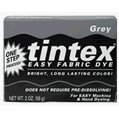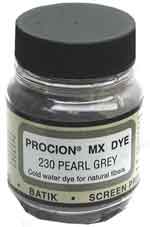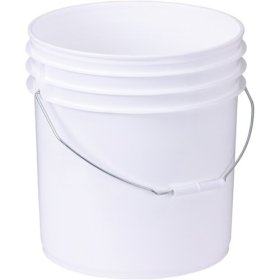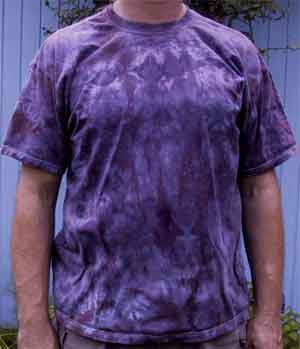I have a light blue cotton shirt that doesn't come in black that I found on clearance. Now I want to make the shirt a medium gray color, don't care how even the color is, just don't want it baby blue colored.
Name: miles
Message: Hi there, I came across your site via a search for black cotton fabric dye. I have a light blue cotton shirt that doesn't come in black that I found on clearance. Now I want to make the shirt a medium gray color, don't care how even the color is, just don't want it baby blue colored. Can you tell me the best way to do this and sell me the necessary products? Thanks in advance.
If the shirt is not stain-resistant or permanent-press, and is 100% cotton, chances are good that you can change its color successfully. The stitching is probably polyester and will stay its current color. Will that be a problem for you? Sometimes, rarely, one panel of a shirt will turn out to be from a different bolt of fabric than another, and, although apparently the same color to begin with, will take the dye to a different intensity and no longer match the rest of the garment. So, there is never any guarantee that a particular garment will dye successfully, but it usually works.

I advise against the use of all-purpose dyes, such as Rit® or Tintex®, because they require very hot water to attach as well as they can, which will probably shrink your shirt; they work best on the stovetop, but devoting a large cooking pot to dyeing is expensive for someone who rarely dyes, because you should never reuse a dyepot for food; and because these dyes bleed in the laundry and fade quickly. (The problem of fading in the laundry can be solved with a cationic dye fixative such as Retayne, but that will increase lightfading, so it's not a perfect solution.)

The best dye to use would be a cool water fiber reactive dye, such as Procion MX dye. Don't buy a black dye when what you want is gray. Not all black dyes will make a grey when diluted; using a small amount of a black dye may produce a purplish color, or a greenish one, or a bluish one. I do not recommend attempting to mix your own dye color when attempting to make a grey, because a neutral grey is difficult to achieve, a project only for the expert dyer. If you want grey dye, buy it grey. A mixture that should work well for you is Jacquard's 230 Pearl Gray. Your pale blue will mix with the dye color, since dye is transparent, giving it a slightly blue tinge, but since the original color of your shirt is pale, it should not be a problem. Another option would be to buy Dylon Permanent Dye in "12 Black", if you can find this dye at your local fabric store; note that it is not the same dye as Dylon Cold Water dye (which works well but is a different dye) or Dylon Multi Purpose Dye (which you should avoid since it is another all-purpose dye).
The easiest way to dye anything a perfectly smooth solid color is
in the washing machine, but this can take a lot of dye, since there is so much
water involved. You can also do your dyeing in a five-gallon bucket, using a
long-handled plastic spoon or pole to stir constantly for about an hour, to make
sure that the dye is distributed evenly. I find this very tiring and prefer the
washing machine method. See "How can I dye
clothing or fabric in the washing machine?". The method is very
similar either way. In either case, for immersion dyeing, you will need
soda
ash, which raises the pH of
the cotton and allows the dye to react with it, and you will need some
ordinary salt to overcome
the high ratio of water to dye.
is
in the washing machine, but this can take a lot of dye, since there is so much
water involved. You can also do your dyeing in a five-gallon bucket, using a
long-handled plastic spoon or pole to stir constantly for about an hour, to make
sure that the dye is distributed evenly. I find this very tiring and prefer the
washing machine method. See "How can I dye
clothing or fabric in the washing machine?". The method is very
similar either way. In either case, for immersion dyeing, you will need
soda
ash, which raises the pH of
the cotton and allows the dye to react with it, and you will need some
ordinary salt to overcome
the high ratio of water to dye.
If you don't care at all how smooth and even the color is, then you can avoid all the stirring, and
the use of the washing machine, by using a different dyeing technique, called
low water immersion dyeing, or LWI. You use exactly the same materials, but put
them all in a small bucket, without stirring. This is an incredibly easy method
of dyeing. For more information, see "How to Do Low
Water Immersion Dyeing". Follow the instructions on that page. You
will need one to three teaspoons of dye (depending on how dark you want it), and
several teaspoons of soda ash; the use of salt is optional (but if you add it,
do so after dissolving the dye, since salt makes it more difficult to dissolve
dye). Note that a premixed dye color, such as grey, will separate out into
multiple colors on the fabric in LWI; this can be very rewarding, but if you
don't want color separation, you can use a single-hue, unmixed pure dye color,
as on my chart at this page: "Which Procion MX
colors are pure, and which mixtures?".
and
the use of the washing machine, by using a different dyeing technique, called
low water immersion dyeing, or LWI. You use exactly the same materials, but put
them all in a small bucket, without stirring. This is an incredibly easy method
of dyeing. For more information, see "How to Do Low
Water Immersion Dyeing". Follow the instructions on that page. You
will need one to three teaspoons of dye (depending on how dark you want it), and
several teaspoons of soda ash; the use of salt is optional (but if you add it,
do so after dissolving the dye, since salt makes it more difficult to dissolve
dye). Note that a premixed dye color, such as grey, will separate out into
multiple colors on the fabric in LWI; this can be very rewarding, but if you
don't want color separation, you can use a single-hue, unmixed pure dye color,
as on my chart at this page: "Which Procion MX
colors are pure, and which mixtures?".
For dyeing up to five pounds of fabric in the washing machine, you will need about 40 grams of dye, 7.5 pounds of salt, and one and a half cups of soda ash. For dyeing one pound of fabric in a five-gallon bucket, you will need about eight grams (or one tablespoon) of dye powder, 1.5 pounds of salt, and 5 tablespoons of soda ash. A small (2/3 ounce) jar of Jacquard Procion MX dye contains about 19 grams of dye powder. The small jar of dye is adequate for dyeing one or two shirts in a bucket, but you need to buy an eight-ounce jar of powder if you want to dye larger quantities of fabric in the washing machine.
Here are links to buy what you need through my web site, ordering from Amazon:
2/3 ounce jar Jacquard Procion MX 230 Pearl Gray ($3.14)
8 ounce jar Jacquard Procion MX 230 Pearl Gray ($9.61)
5 pound bag of soda ash dye activator ($4.76)
Depending on how you choose to do your dyeing, you may also need a
5-gallon plastic bucket, which you can buy locally, and several boxes of
non-iodized table salt or pickling salt from the grocery store.
(Please help support this web site. Thank you.)
Message: Hi there, I came across your site via a search for black cotton fabric dye. I have a light blue cotton shirt that doesn't come in black that I found on clearance. Now I want to make the shirt a medium gray color, don't care how even the color is, just don't want it baby blue colored. Can you tell me the best way to do this and sell me the necessary products? Thanks in advance.
If the shirt is not stain-resistant or permanent-press, and is 100% cotton, chances are good that you can change its color successfully. The stitching is probably polyester and will stay its current color. Will that be a problem for you? Sometimes, rarely, one panel of a shirt will turn out to be from a different bolt of fabric than another, and, although apparently the same color to begin with, will take the dye to a different intensity and no longer match the rest of the garment. So, there is never any guarantee that a particular garment will dye successfully, but it usually works.

I advise against the use of all-purpose dyes, such as Rit® or Tintex®, because they require very hot water to attach as well as they can, which will probably shrink your shirt; they work best on the stovetop, but devoting a large cooking pot to dyeing is expensive for someone who rarely dyes, because you should never reuse a dyepot for food; and because these dyes bleed in the laundry and fade quickly. (The problem of fading in the laundry can be solved with a cationic dye fixative such as Retayne, but that will increase lightfading, so it's not a perfect solution.)

The best dye to use would be a cool water fiber reactive dye, such as Procion MX dye. Don't buy a black dye when what you want is gray. Not all black dyes will make a grey when diluted; using a small amount of a black dye may produce a purplish color, or a greenish one, or a bluish one. I do not recommend attempting to mix your own dye color when attempting to make a grey, because a neutral grey is difficult to achieve, a project only for the expert dyer. If you want grey dye, buy it grey. A mixture that should work well for you is Jacquard's 230 Pearl Gray. Your pale blue will mix with the dye color, since dye is transparent, giving it a slightly blue tinge, but since the original color of your shirt is pale, it should not be a problem. Another option would be to buy Dylon Permanent Dye in "12 Black", if you can find this dye at your local fabric store; note that it is not the same dye as Dylon Cold Water dye (which works well but is a different dye) or Dylon Multi Purpose Dye (which you should avoid since it is another all-purpose dye).
The easiest way to dye anything a perfectly smooth solid color
 is
in the washing machine, but this can take a lot of dye, since there is so much
water involved. You can also do your dyeing in a five-gallon bucket, using a
long-handled plastic spoon or pole to stir constantly for about an hour, to make
sure that the dye is distributed evenly. I find this very tiring and prefer the
washing machine method. See "How can I dye
clothing or fabric in the washing machine?". The method is very
similar either way. In either case, for immersion dyeing, you will need
soda
ash, which raises the pH of
the cotton and allows the dye to react with it, and you will need some
ordinary salt to overcome
the high ratio of water to dye.
is
in the washing machine, but this can take a lot of dye, since there is so much
water involved. You can also do your dyeing in a five-gallon bucket, using a
long-handled plastic spoon or pole to stir constantly for about an hour, to make
sure that the dye is distributed evenly. I find this very tiring and prefer the
washing machine method. See "How can I dye
clothing or fabric in the washing machine?". The method is very
similar either way. In either case, for immersion dyeing, you will need
soda
ash, which raises the pH of
the cotton and allows the dye to react with it, and you will need some
ordinary salt to overcome
the high ratio of water to dye.If you don't care at all how smooth and even the color is, then you can avoid all the stirring,
 and
the use of the washing machine, by using a different dyeing technique, called
low water immersion dyeing, or LWI. You use exactly the same materials, but put
them all in a small bucket, without stirring. This is an incredibly easy method
of dyeing. For more information, see "How to Do Low
Water Immersion Dyeing". Follow the instructions on that page. You
will need one to three teaspoons of dye (depending on how dark you want it), and
several teaspoons of soda ash; the use of salt is optional (but if you add it,
do so after dissolving the dye, since salt makes it more difficult to dissolve
dye). Note that a premixed dye color, such as grey, will separate out into
multiple colors on the fabric in LWI; this can be very rewarding, but if you
don't want color separation, you can use a single-hue, unmixed pure dye color,
as on my chart at this page: "Which Procion MX
colors are pure, and which mixtures?".
and
the use of the washing machine, by using a different dyeing technique, called
low water immersion dyeing, or LWI. You use exactly the same materials, but put
them all in a small bucket, without stirring. This is an incredibly easy method
of dyeing. For more information, see "How to Do Low
Water Immersion Dyeing". Follow the instructions on that page. You
will need one to three teaspoons of dye (depending on how dark you want it), and
several teaspoons of soda ash; the use of salt is optional (but if you add it,
do so after dissolving the dye, since salt makes it more difficult to dissolve
dye). Note that a premixed dye color, such as grey, will separate out into
multiple colors on the fabric in LWI; this can be very rewarding, but if you
don't want color separation, you can use a single-hue, unmixed pure dye color,
as on my chart at this page: "Which Procion MX
colors are pure, and which mixtures?".For dyeing up to five pounds of fabric in the washing machine, you will need about 40 grams of dye, 7.5 pounds of salt, and one and a half cups of soda ash. For dyeing one pound of fabric in a five-gallon bucket, you will need about eight grams (or one tablespoon) of dye powder, 1.5 pounds of salt, and 5 tablespoons of soda ash. A small (2/3 ounce) jar of Jacquard Procion MX dye contains about 19 grams of dye powder. The small jar of dye is adequate for dyeing one or two shirts in a bucket, but you need to buy an eight-ounce jar of powder if you want to dye larger quantities of fabric in the washing machine.
Here are links to buy what you need through my web site, ordering from Amazon:
2/3 ounce jar Jacquard Procion MX 230 Pearl Gray ($3.14)
8 ounce jar Jacquard Procion MX 230 Pearl Gray ($9.61)
5 pound bag of soda ash dye activator ($4.76)
Depending on how you choose to do your dyeing, you may also need a
5-gallon plastic bucket, which you can buy locally, and several boxes of
non-iodized table salt or pickling salt from the grocery store.
(Please help support this web site. Thank you.)
Posted: Wednesday - November 14, 2007 at 09:12 AM
Follow this blog on twitter here.
Quick Links
- All About Dyes & Dyeing Top -
- Top of this blog -
- FAQ -
- The Dye Forum -
- How to Tie Dye - How to Batik -
- Books - Toys - Plants -
- Top of this blog -
- FAQ -
- The Dye Forum -
- How to Tie Dye - How to Batik -
- Books - Toys - Plants -
More in this category:
- -
Statistics
Total entries in this blog:
Total entries in this category:
Published On: Aug 29, 2012 02:48 PM
Total entries in this category:
Published On: Aug 29, 2012 02:48 PM